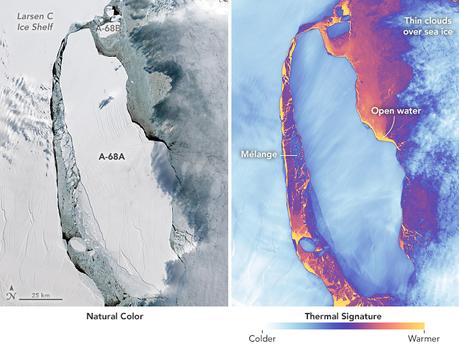 When the massive chunk of ice separated from the Larsen C Ice Shelf in Antarctica back in July, it did so under the cover of the long Antarctic night. But now that spring has arrived at the bottom of the world, we're getting our first daytime look at the massive slab of ice thanks to some satellite photos from NASA, helping to put things into perspective to a degree.
When the massive chunk of ice separated from the Larsen C Ice Shelf in Antarctica back in July, it did so under the cover of the long Antarctic night. But now that spring has arrived at the bottom of the world, we're getting our first daytime look at the massive slab of ice thanks to some satellite photos from NASA, helping to put things into perspective to a degree.According to reports, the new iceberg has been dubbed A-68 by the U.S. National Ice Center, which tracks large objects like this one as they head out into the sea. Later, a smaller – but still substantial – chunk of ice broke from from the original berg, prompting a new designation. The larger of the two was renamed A-68A, while the smaller became A-68B.
As you can see from the photo above, both chunks of ice are still sticking fairly close to the Antarctic continent, and haven't drifted into the Southern Ocean to any significant degree. But, as A-68A continues to break apart, it will likely begin to travel north, where it could cause issues for shipping traffic.
The photos were taken by NASA's Terra satellite, with the one on the left being snapped on September 11, giving researchers their first view of the massive iceberg in its true colors and state. The image on the left was captured using thermal imaging to show the temperature differences between the ice and than the water that it is sitting in. That warmer water will help with the break-up process, which will probably be accelerated as the austral summer warms things up.
Speaking of which, we're now just a few weeks away from the start of the Antarctic skiing season. As usual, a number of adventurers will be heading to the frozen continent to make the ski journey to the South Pole. That time of year always brings some interesting stories, so stay tuned for plenty of coverage in the days ahead.

